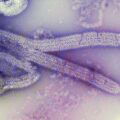A type of cancer treatment called photodynamic therapy is giving recipients superhuman night vision. While temporary, the researchers looking into the actual mechanisms behind the unexpected side effect believe their findings may help those suffering from an array of vision limiting conditions, while also proving the increasingly robust nature of molecular modeling software.
BACKGROUND: NIGHT VISION EFFECT KNOWN BUT NOT UNDERSTOOD
Photodynamic therapy is used to kill malignant cancer cells within the eye. The process involves chemicals combined with focused light to attack these malignant cells directly. However, since its inception, patients undergoing the treatment began to see things. In some cases it was an outline or halo in low light conditions, but in many cases the main side effect was the ability to see in the dark.
In 2015, a group of self-professed “bio-hackers” proved the effect by giving one of their team night vision that reportedly allowed him to see over 50 meters distance in total darkness, an effect that lasted for hours.
Now, a group of researchers using sophisticated modeling software and a heavy dose of complex calculations were able to figure out what mechanism is behind this superhuman side effect, and if it can be harnessed to treat people suffering from a range of vision-related conditions.
ANALYSIS: NIGHT VISION PROCESS SEES THE LIGHT
To better understand what was giving patients night vision, the research team behind the study employed complex modeling software that is able to simulate the movement of individual atoms, as well as mimic the formation of chemical bonds at a molecular level. These simulations ran for months before zeroing in on the actual process behind the night vision ability.
Specifically, one of the chemicals used in this type of cancer treatment called chlorin e6 was interacting with Rhodopsin, a protein already inside the human eye. As this chlorin e6 absorbs the infrared radiation portion of the cancer-killing light, it would react with the oxygen already in the eye tissue to create a highly reactive singlet oxygen. At the same time, the visible light used in the cancer treatment was causing a chemical called retinol to become separated from the Rhodopsin. Once this retinol interacts with the singlet oxygen, it is converted into the electrical signal sent to the brain’s vision center, thereby amplifying the patient’s ability to see in low light conditions.
Voila! Instant night vision.
“This explains the increase in night-time visual acuity,” explained chemist Antonio Monari, from the University of Lorraine in France, in an interview for CNRS. “However, we did not know precisely how rhodopsin and its active retinal group interacted with chlorin. It is this mechanism that we have now succeeded in elucidating via molecular simulation.”
OUTLOOK: PROMISING TREATMENTS FOR THE VISUALLY IMPAIRED
The researchers note that their results point to a possible pathway for treating folks with night blindness, or an over sensitivity to light. However, they also note that the dramatic success of their molecular software simulations points to an even greater potential benefit.
“Molecular simulation is already being used to shed light on fundamental mechanisms – for example, why certain DNA lesions are better repaired than others – and enable the selection of potential therapeutic molecules by mimicking their interaction with a chosen target,” Monari told CNRS.
Follow and connect with author Christopher Plain on Twitter: @plain_fiction
